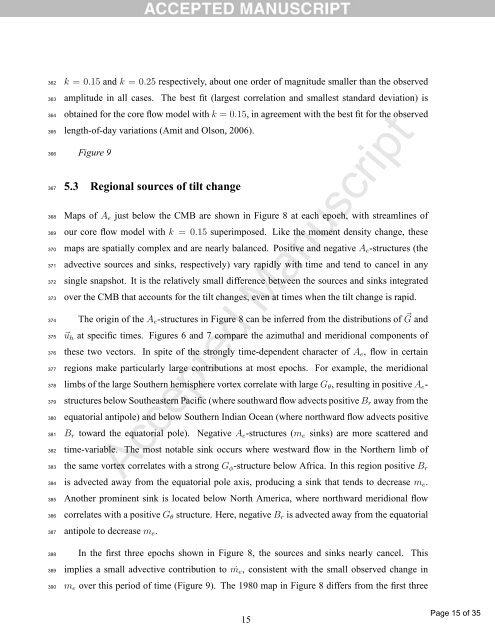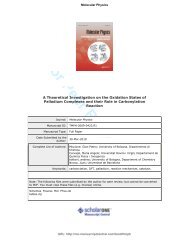Accepted Manuscript - TARA
Accepted Manuscript - TARA
Accepted Manuscript - TARA
Create successful ePaper yourself
Turn your PDF publications into a flip-book with our unique Google optimized e-Paper software.
362<br />
363<br />
364<br />
365<br />
366<br />
367<br />
368<br />
369<br />
370<br />
371<br />
372<br />
373<br />
374<br />
375<br />
376<br />
377<br />
378<br />
379<br />
380<br />
381<br />
382<br />
383<br />
384<br />
385<br />
386<br />
387<br />
k = 0.15 and k = 0.25 respectively, about one order of magnitude smaller than the observed<br />
amplitude in all cases. The best fit (largest correlation and smallest standard deviation) is<br />
obtained for the core flow model with k = 0.15, in agreement with the best fit for the observed<br />
length-of-day variations (Amit and Olson, 2006).<br />
Figure 9<br />
5.3 Regional sources of tilt change<br />
Maps of A e just below the CMB are shown in Figure 8 at each epoch, with streamlines of<br />
our core flow model with k = 0.15 superimposed. Like the moment density change, these<br />
maps are spatially complex and are nearly balanced. Positive and negative A e -structures (the<br />
advective sources and sinks, respectively) vary rapidly with time and tend to cancel in any<br />
single snapshot. It is the relatively small difference between the sources and sinks integrated<br />
over the CMB that accounts for the tilt changes, even at times when the tilt change is rapid.<br />
The origin of the A e -structures in Figure 8 can be inferred from the distributions of G ⃗ and<br />
⃗u h at specific times. Figures 6 and 7 compare the azimuthal and meridional components of<br />
these two vectors. In spite of the strongly time-dependent character of A e , flow in certain<br />
regions make particularly large contributions at most epochs. For example, the meridional<br />
limbs of the large Southern hemisphere vortex correlate with large G θ , resulting in positive A e -<br />
structures below Southeastern Pacific (where southward flow advects positive B r away from the<br />
equatorial antipole) and below Southern Indian Ocean (where northward flow advects positive<br />
B r toward the equatorial pole). Negative A e -structures (m e sinks) are more scattered and<br />
time-variable. The most notable sink occurs where westward flow in the Northern limb of<br />
<strong>Accepted</strong> <strong>Manuscript</strong><br />
the same vortex correlates with a strong G φ -structure below Africa. In this region positive B r<br />
is advected away from the equatorial pole axis, producing a sink that tends to decrease m e .<br />
Another prominent sink is located below North America, where northward meridional flow<br />
correlates with a positive G θ structure. Here, negative B r is advected away from the equatorial<br />
antipole to decrease m e .<br />
388<br />
389<br />
390<br />
In the first three epochs shown in Figure 8, the sources and sinks nearly cancel. This<br />
implies a small advective contribution to<br />
m˙<br />
e , consistent with the small observed change in<br />
m e over this period of time (Figure 9). The 1980 map in Figure 8 differs from the first three<br />
15<br />
Page 15 of 35
















